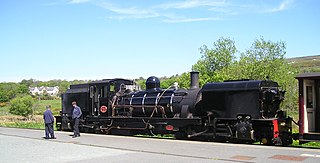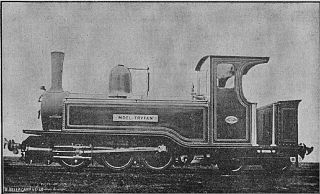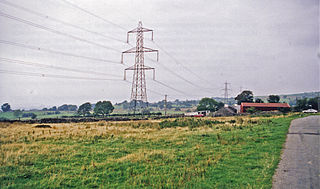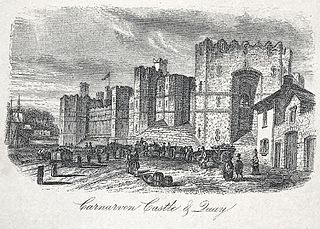
The Ffestiniog Railway is a heritage railway based on 1 ft 11+1⁄2 in narrow-gauge, located in Gwynedd, Wales. It is a major tourist attraction located mainly within the Snowdonia National Park.

The Welsh Highland Railway is a 25-mile (40.2 km) long, restored 1 ft 11+1⁄2 in narrow gauge heritage railway in the Welsh county of Gwynedd, operating from Caernarfon to Porthmadog, and passing through a number of popular tourist destinations including Beddgelert and the Aberglaslyn Pass. At Porthmadog it connects with the Ffestiniog Railway and to the short Welsh Highland Heritage Railway. In Porthmadog it uses the United Kingdom's only mixed gauge flat rail crossing.

The North Wales Narrow Gauge Railways (NWNGR) was a railway company that planned to build a number of inter-connected 1 ft 11+1⁄2 in narrow-gauge railways across North Wales. The first two of these lines - jointly known as the "Moel Tryfan Undertaking" - were authorised by Act of Parliament 1872 and were built and opened in the 1870s. The original main line ran from Dinas Junction to Bryngwyn and opened in 1877. The second line was a branch from Tryfan Junction to South Snowdon, though shortly after opening, the company designated the Tryfan Junction to Bryngwyn section as the branch, and the Dinas Junction to South Snowdon section as the main line.

Russell is a narrow gauge steam locomotive originally built in 1906 for the North Wales Narrow Gauge Railways (NWNGR), but most famously associated with the original Welsh Highland Railway (WHR), and now based at the Welsh Highland Heritage Railway in Porthmadog.

The Porthmadog cross town link is a section of the 1 ft 11+1⁄2 in narrow gauge Welsh Highland Railway, specifically built to link with the Ffestiniog Railway in Porthmadog, and runs along partly what was called the Junction Railway, previously existing as part of the original Welsh Highland Railway. This had been removed some time after that railway closed in 1936.

Porthmadog Harbour railway station in Porthmadog, Gwynedd, North Wales. It is the passenger terminus of two narrow gauge railways: the Ffestiniog Railway, which was opened in 1836 to carry dressed slate from the Quarries around Blaenau Ffestiniog to the sea port of Porthmadog, for export by sea; and the Welsh Highland Railway, incorporated in 1923, which ran to Dinas. After rebuilding in 1997-2011, the other terminus is at Caernarfon, in sight of the Castle.

Waunfawr is a station on the narrow gauge Welsh Highland Railway, which was built in 1877 as the North Wales Narrow Gauge Railways Moel Tryfan Undertaking, to carry dressed slate to Dinas Junction on the London and North Western Railway. Passenger services ceased on 26 September 1936 and the station was reopened on 7 August 2000 following the reconstruction of the railway from Dinas to Waunfawr. The train services are operated by the Festiniog Railway Company.

Rhyd Ddu is a station on the narrow gauge Welsh Highland Railway, which was built in 1881 as the North Wales Narrow Gauge Railways Moel Tryfan Undertaking to carry dressed slate to Dinas Junction on the LNWR. It has also previously been named both "Snowdon" and "South Snowdon".

Dinas is a station on the narrow gauge Welsh Highland Railway, which was built in 1877 as the North Wales Narrow Gauge Railways Moel Tryfan Undertaking to carry dressed slate for trans-shipment to the LNWR. Passenger services ceased on 26 September 1936 until which time Dinas had been a joint station, known as Dinas Junction with the LNWR and later the LMS. In 1951, British Railways closed their part of the station but the line through the station remained open until the line from Caernarvon to Afon Wen was closed in 1964. The trackbed was subsequently developed as the Lôn Eifion tourist cycle route.

Beddgelert railway station is a railway station on the narrow gauge Welsh Highland Railway in North Wales.

The Nantlle Railway was a Welsh narrow gauge railway. It was built to carry slate from several slate quarries across the Nantlle Valley to the harbour at Caernarfon for export by sea. The line provided a passenger service between Caernarfon and Talysarn from 1856 to 1865. It was the first public railway to be operated in North Wales.

Caernarvon railway station was a station on the former Bangor and Carnarvon Railway between Caernarfon, Gwynedd and Menai Suspension Bridge near Bangor. The station was closed to all traffic in January 1972. The station has since been demolished and the site redeveloped.
The restoration of the Welsh Highland Railway has a colourful and complex history. This article provides the modern history.

The Welsh Highland Heritage Railway is a short reconstructed heritage railway in Gwynedd, Wales. Its main station is in Porthmadog.

Moel Tryfan was a narrow gauge steam locomotive built for use on the North Wales Narrow Gauge Railways (NWNGRs) in 1874/5. The locomotive was an 0-6-4T single Fairlie locomotive built by the Vulcan Foundry near Manchester. It spent its entire working life on the NWNGRs and its successors the Welsh Highland Railway (WHR) and the Ffestiniog Railway (FfR).

Bryngwyn railway station is a former station which was the terminus for passengers on the Bryngwyn Branch of the North Wales Narrow Gauge Railways, and later the Welsh Highland Railway. Beyond the station, an incline climbed the slope of Moel Tryfan to serve a series of slate quarries. Those connected by tramways to the incline head included the Alexandra quarry, Moel Tryfan quarry, Fron quarry, Braich quarry and Cilgwyn quarry.

Tryfan Junction is a junction station on the North Wales Narrow Gauge Railways for the main line and the Bryngwyn Branch. Opened in 1877, it closed in 1936 and the building fell into ruin. It was reopened as a request stop in 2011, and the station renovated.
The original Welsh Highland Railway (WHR) owed its existence to the narrow gauge railways and tramways built to serve commercial slate traffic from slate quarries and other mineral extraction operations along its route.

Hafod y Llyn is a halt in North Wales on the Welsh Highland Railway, located between Beddgelert and Pont Croesor. It had been a halt, with a siding for a period on the original WHR, and a temporary terminus during the rebuilding of the line.

Carnarvon Castle railway station was opened in 1856 by the narrow gauge Nantlle Railway near the foot of what is today the Allt Y Castell which slopes down to Caernarfon's harbour area. It was the line's northern terminus and was the closest of Caernarfon's ultimately five stations to the historic town centre.


















